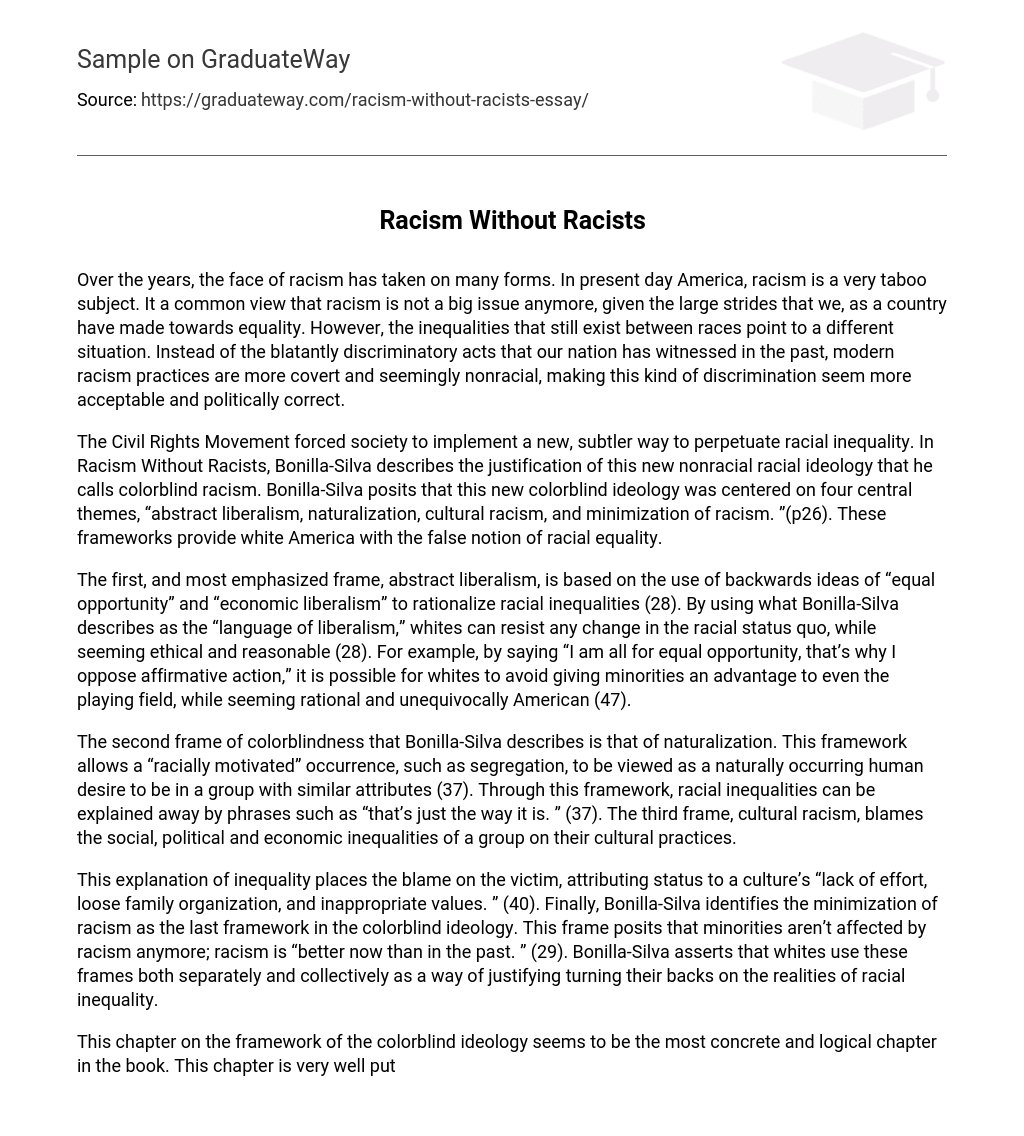Throughout the years, racism has manifested in different ways. In present-day America, it is considered a taboo topic and many believe that it is no longer a major problem because of the progress made towards equality. However, persistent racial disparities suggest otherwise. Instead of the explicit acts of discrimination seen in the past, contemporary racism is more hidden and appears to be unrelated to race, which has made this form of prejudice seem more socially acceptable and politically appropriate.
The implementation of the Civil Rights Movement led to the emergence of a more subtle method for maintaining racial inequality, which is described as colorblind racism by Bonilla-Silva in Racism Without Racists. This new racial ideology, according to Bonilla-Silva, is based on four main themes, namely “abstract liberalism, naturalization, cultural racism, and minimization of racism.” (p26). White America is deceived by these frameworks into believing in the illusion of racial equality.
According to Bonilla-Silva, the first and most emphasized frame is known as abstract liberalism. This frame relies on the backward concepts of “equal opportunity” and “economic liberalism” to justify racial inequalities (28). By utilizing what Bonilla-Silva refers to as the “language of liberalism,” white individuals can resist changing the racial status quo while appearing ethical and logical (28). For instance, they can oppose affirmative action by stating, “I support equal opportunity, which is why I am against affirmative action,” thereby avoiding giving minorities an advantage to level the playing field, all while coming across as rational and truly American (47).
According to Bonilla-Silva, the second frame of colorblindness is naturalization. This perspective sees racially motivated events, like segregation, as being a natural human inclination to be part of a group with similar attributes (37). By adopting this framework, racial inequalities can be dismissed with phrases like “that’s just the way it is” (37). The third frame, known as cultural racism, attributes the social, political, and economic inequalities experienced by a group to their cultural practices.
This explanation of inequality attributes status to a culture’s “lack of effort, loose family organization, and inappropriate values” (40), placing the blame on the victim. Bonilla-Silva identifies the minimization of racism as the final framework in the colorblind ideology. According to this perspective, minorities are no longer affected by racism; racism is now “better than in the past” (29). Bonilla-Silva maintains that whites use these frames individually and collectively to justify ignoring the realities of racial inequality.
This chapter provides a solid and logical exploration of the colorblind ideology. It is well-structured and includes a diverse range of examples. The author effectively illustrates how these frameworks intersect. The idea that these frameworks act as a barrier for whites in acknowledging the racial reality of the US is a logical explanation for the existence of a “racism without racists” culture (47).
According to Bonilla-Silva, changing attitudes towards race relations have led to a transformation in the expression of racist ideologies. He highlights the concept of color-blindness, stating that in the post-Civil Rights era, white individuals had to adapt their language when discussing racism in order to promote white privilege without appearing racist. Bonilla-Silva argues that color-blind racism encompasses specific linguistic tools that enable individuals to convey its frames of thought (53). However, this chapter may seem somewhat forced in terms of Bonilla-Silva’s explanation of language as an indicator of racism. In many instances, the five elements of “race-talk” outlined by Bonilla-Silva do not necessarily demonstrate racism. Some examples provided by Bonilla-Silva appear to manipulate respondents’ answers to come across as more racist than intended. Additionally, the wording and manner in which questions were posed during interviews, as well as the comfort level of respondents in answering truthfully, could influence the language used in their responses.
Moreover, in my perspective, this chapter primarily discusses society’s reluctance to openly discuss racism due to the fear of social exclusion for making racially insensitive remarks. I believe that it is essential to consider external factors before analyzing responses to oral questions for racial implications. People have varying understandings of race and racism influenced by their unique encounters and experiences, which creates challenges in accurately assessing an individual’s comments as racist.
This chapter raises the issue of how to discuss racism when the majority of comments on the topic are excessively examined and, as in the case of this book, ultimately labeled as racist. I believe that racism is a sensitive subject for many individuals, and books like this only partially contribute to resolving the matter. Bonilla-Silva unfairly attributes a majority of responsibility for this new racial ideology and the persistence of racial inequality to white individuals.
Bonilla-Silva’s depiction of white individuals, excluding lower class women in Chapter 6, is critical and appears to be heavily biased. This could weaken the reliability of the findings he derives from his experiment. Nonetheless, this book has the capacity to have a positive influence on race relations by addressing an often overlooked issue. Even if it achieves nothing else, Bonilla-Silva’s work showcases that while racism may not vanish completely from society, its structure can evolve due to political and social factors.
In the present-day United States, racism is concealed and deceptive, much like a wolf wearing sheep’s clothing. While it may be challenging to come across someone openly proclaiming their racist views, upon closer examination, most individuals hold more prejudiced beliefs than they are willing to admit. Although books like this one contribute partly towards achieving tolerance and equality through racial education, they also have their limitations. This book exposes some of the prominent manifestations of colorblind racism, stimulating conversations about racial discrimination in America today. However, its biased approach and the conclusions it presents fail to foster acceptance of diverse races.





